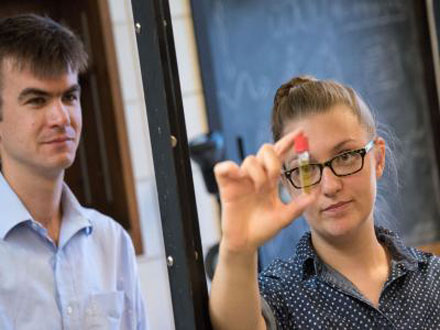A discovery about how some molecules produce light, in apparent contradiction of Kasha’s Rule, could have several applications, from industrial to biomedical.
To explore the origin of aggregation-induced emission, researchers from the University of Vermont and Dartmouth College assessed the emission properties of a series of BF2–hydrazone-based dyes as a function of solvent viscosity. They found these molecules to be highly efficient fluorescent molecular rotors.

University of Vermont doctoral student Morgan Cousins holds up a
sample of a solution of strange rotor molecules made from boron-based
dye. Led by UVM chemistry professor Matt Liptak (left),
she was part of a team that tested the dye and discovered how the
molecules can release a bright fluorescent glow. It's a new method to
create light.Courtesy of Joshua Brown.
Further examination of the emission mechanism of the molecules revealed that the emission was not from the S1 state, as would be expected from Kasha's Rule, but from a higher energy state. Fluorescence could be enhanced by restricting the molecular rotor’s rotation and suppressing the internal conversion to the dark S1 state. When placed in a thin liquid, the rotating molecules gave off a weak, reddish luminescent glow. However, when the molecules were put into thicker solvents (in this case, mixtures of glycerol and ethylene glycol), the fluorescent light from the molecular rotors, instead of becoming weaker, glowed brightly in a vivid green color nearer the blue end of the spectrum.
The paddle-shaped part of the rotor must be able to rotate freely in order to activate the chemical pathway that allows it to give off heat energy; but in a thick solution this rotation is suppressed. The thicker the solution, the less the molecular paddles rotate; and the less the rotation, the more light can be emitted.
The phenomenon led the researchers to propose that suppression of Kasha's Rule was the photophysical mechanism responsible for emission in both the viscous solution and the solid state. The team has called their discovery Suppression of Kasha's Rule, or SOKR.
"One way to understand SOKR is to think about a water slide with two outlets where one outlet is located far above the pool and the other is located at the level of the pool," said professor Matthew Liptak. "In low viscosity solutions like water, the paddles rush all the way to the bottom outlet and enter the pool without a splash. In high viscosity solutions like maple syrup, the paddles are slowed down, allowing some to spill out the top outlet, creating a waterfall or, in the case of light-emitting molecular rotors, bright green light.
The novel pathway to creating light may have practical use.
"The compound we found is very bright, and due to its viscosity sensitivity, may have a multitude of applications," said researcher Morgan Cousins. "We see uses for these kinds of molecules from industrial materials to new kinds of LEDs to biomedical imaging."
The SOKR molecules are not safe for use in a human, but the team is currently hunting for similar "bio-compatible" compounds, Liptak says, that could be incorporated into a medical dye or other test where they would glow brightly in more viscous parts of a cell and less in more watery parts. The molecules could be applied as a sensitive diagnostic tool because they precisely change the amount of light they emit based on the thickness of the solution in which they are placed.
The research was published in Nature Chemistry (doi:10.1038/nchem.2612).
When the rotor molecules are in a thick solution, their capacity to vibrate is limited and so they emit light before they are done vibrating, as shown here. This is called the "bright state." This is because the paddle-shaped part of the rotor must rotate freely in order to turn on the chemical pathway that allows it to give off heat energy -- but this rotation is suppressed in a thick solution. The thicker the solution, the less the molecular paddles rotate, the more light can be emitted. Courtesy of Morgan Cousins and Matt Liptak.